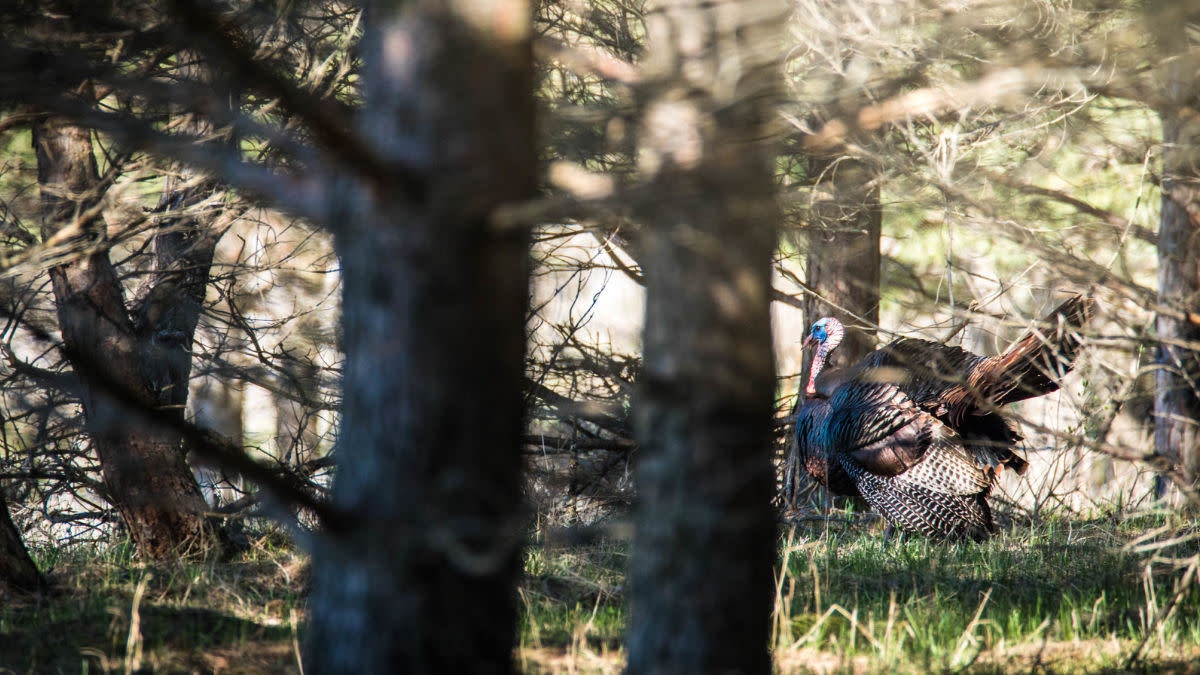
On the surface, the idea of taking to the woods to shoot a turkey appears simple. Listen for one to gobble, slink in its direction, make a few imitation hen calls, and shoot it in the face. After all, they have brains the size of a peanut and lack the superb sense of smell that makes hunting your typical quarry such a challenge.
But spend any amount of time chasing turkeys on public land and you’ll quickly be humbled—these gobblers are a completely different animal and require a different approach in the woods.
Don’t Stop Scouting
Over the years, nothing has helped me kill turkeys more than having a good understanding of a flock’s core area and pattern of daily movement. Turkeys are creatures of habit, and if undisturbed, they will likely hang out in the same places they did yesterday. They might not be as pattern-able as deer, but turkeys will occupy the same general areas week after week.
Although their travel routes may seem completely random and leave you dumbfounded, all you need to do is get in their core area to stay in the game. If you’re trying to call a tom into a spot he doesn’t normally hang out, you’ll be met with the kind of hesitancy that public land gobblers are known for.
Like with any public lands pursuit, patterns always change after opening weekend. Birds are likely to become reclusive and much harder to locate. Don’t give up, though. If you’ve done your homework and have a few flocks pinned, you still have the upper hand. Flocks that get bumped by hunters won’t go far from their original home range. Rather than completely starting over and blindly surveying a new area, hunt the birds you know. Usually it’s as simple as getting a bit further from the road to find the new spots that gobblers are roosting, scratching, and feeding.
Hunt Midday
Understanding turkey behavior reveals habits and tendencies that hunters can take advantage of. Most of the year, turkeys tend to roost together in large flocks. At sunrise, pulling a tom away from his rafter of hens is a difficult task. That is, unless you’re in his customary strut zone or a location that hens frequent shortly after fly-down.
As the day progresses, flocks often disperse. Right around 10 a.m., toms wander and lose sight of their comrades or intentionally leave the flock in search of new hens to breed. When this happens, lonely, public land gobblers are as susceptible to calling as they’ll be at any part of the day.
For this reason, the majority of my turkey hunting success has come between the hours of 10 a.m. and 2 p.m. By heading home for a nap after the morning hunt didn’t go your way, you’re leaving the woods at arguably the best part of the day. If you have to, consider sleeping in and take advantage of trolling gobblers at lunchtime.
Less is More
Zach Ferenbaugh of The Hunting Public is no stranger to hunting pressured birds, and his aggressive approach to killing whitetails carries over to spring. He likes to catch toms off guard by mimicking a talkative hen, making them come investigate the surprise acquaintance.
“Once I find turkeys, I personally like to get close before I start calling,” Ferenbaugh said. “I think calling to a bird that is within 100 yards or closer for the first time really ups the odds at getting a shot at that bird.”
Later in the season, though, as birds become educated and flocks disperse, they often become less vocal. Large flocks break up as hens begin searching for nesting grounds, which often decreases their chatter. At this time, the surviving toms are generally less willing to alert you to their whereabouts. As real birds decrease their vocalizations, so should you.
During this period, Ferenbaugh’s calling sequence is simple and leans heavily on soft yelps and single clucks. “For late season, pressured birds I think keeping calls subtle and realistic is key.”
To produce soft yelps, our favorite calls are the Phelps Jake Brake and MeatEater Crystal Over Slate Pot Call. For single clucks, you can’t beat the Phelps Loud and Clear or Black Bat.
As April approaches, it’s time to start putting together a gobbler game plan. In coming weeks, the places you find turkeys will likely be the same exact places they’re hanging out opening morning. Keep tabs on those flocks, sharpen your calling game, and arm yourself with more knowledge to ensure public land success this spring.
Feature image via Captured Creative.





